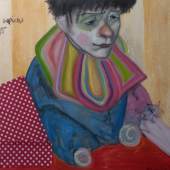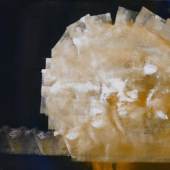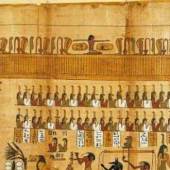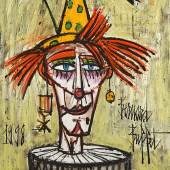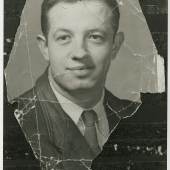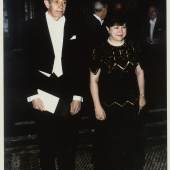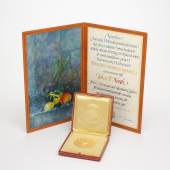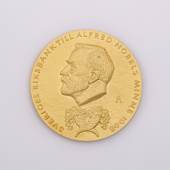Sotheby's New York
Unveils John F. Nash, Jr.'s 1994 Nobel Memorial Prize in Economic Sciences
-
Auktion17.10.2016
NEW YORK, 30 August 2016 – On 17 October 2016 at 2pm, Sotheby’s New York will offer John F. Nash, Jr.'s 1994 Nobel Memorial Prize in Economic Sciences. Perhaps best known to the general public as the protagonist in the 2001 Academy Award-winning film A Beautiful Mind, John F. Nash Jr. was a mathematical genius with graduate degrees from Carnegie Tech and Princeton University. His brilliance and, in particular, his numerous contributions to game theory including the Nash equilibrium – applied to fields as diverse as economics, banking, defense, politics and evolutionary biology – are commemorated in this Nobel Prize, awarded by the Royal Swedish Academy of Sciences in 1994.
Selby Kiffer, Senior Vice President, Books & Manuscripts, noted: “It has been very gratifying to work with the Estate of John F. Nash Jr. to bring this extraordinary man’s Nobel Prize to auction. Nash’s insights into game theory have become so pervasive that they affect our daily lives in ways in many ways, whether or not we are fully cognizant of the operation of the “Nash equilibrium.” Through the film A Beautiful Mind and Nash’s later work in the area of mental health, he has become a symbol of the triumph of the human spirit as well as an icon of twentieth-century mathematical thought. John Nash truly embodied Alfred Nobel’s stipulation that the prizes awarded in his name be given to ‘those who ... shall have conferred the greatest benefit on mankind.’”
John F. Nash Jr. began his academic career at Carnegie Tech (now Carnegie Mellon University) at the age of 17 as a chemical engineering major, and then a chemistry major, before switching over to mathematics, which allowed him the freedom to think, learn and understand in the intuitive and individual manner he preferred. After just three years, Nash graduated with a bachelor’s degree, a master’s degree, and a letter of recommendation from Professor Richard J. Duffin, his faculty advisor, which simply read: “Mr. Nash is nineteen years old and graduates from Carnegie Tech in June. He is a mathematical genius”. With his diplomas and letter of recommendation in hand, John F. Nash Jr. relocated to Princeton University to continue his studies.
While at Carnegie Tech, Nash had taken an elective course in International Economics, which led to his first published paper, ‘The Bargaining Problem’. His nascent interest in game theory was fully kindled at Princeton and led to his 1950 dissertation, ‘Non-Cooperative Games’, which introduced to the world the Nash equilibrium – the concept of a stable solution to a game involving two or more players, which provides all players with their best outcome without adjusting their strategies to account for the other players’ own strategies. It was for this discovery, as well as his introduction of the distinction between cooperative and non-cooperative games, that the Royal Swedish Academy of Sciences awarded Nash the Sveriges Riksbank Prize in Economic Sciences in Memory of Alfred Nobel in 1994.
For John F. Nash, the accolade of the Nobel Prize was a transformative event, particularly in the context of his struggles with mental illness. During an interview at a 2004 meeting of Nobel Laureates in Economic Sciences, Nash acknowledged that the Nobel Prize “had a tremendous impact on my life, more than on the life of most Prize winners because I was in an unusual situation. I was unemployed at the time…And so I was in a position to be very much influenced by the recognition of my earlier work…I had become widely known, but in a sense it wasn’t officially recognized. I was quoted very frequently in the literature of economics and mathematics, but it’s quite different to get official recognition”.
With its gold medal in its original red morocco case, accompanying calligraphic diploma with an original watercolor drawing by Bengt Landin, the original box and attaché case for the diploma, and official letters from the Nobel Foundation and the Royal Swedish Academy of Sciences, John F. Nash, Jr.'s 1994 Nobel Memorial Prize in Economic Sciences is one of the most complete documentations of the Nobel Prize to ever be offered for auction (estimate $2.5/4 million).
-
„Durch die Schrift und den Buch- Druck hat eigentlich der menschliche Geist erst die Welt...
-
06.03.2025Sotheby’s, eines der weltweit führenden Auktionshäuser, beginnt das Jahr 2025 mit einer...
-
17.10.2016Auktion »
.
